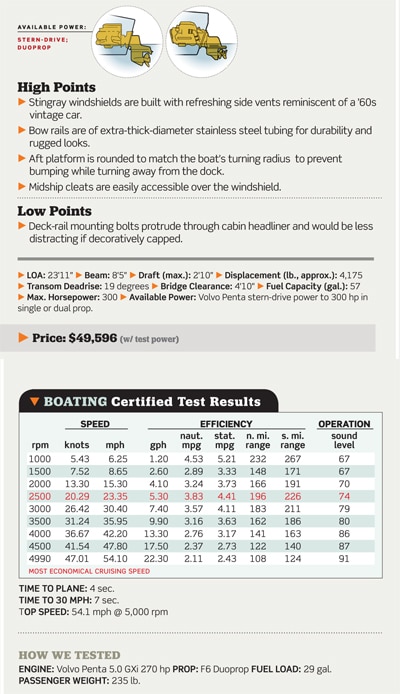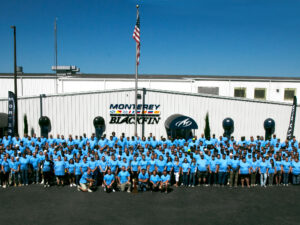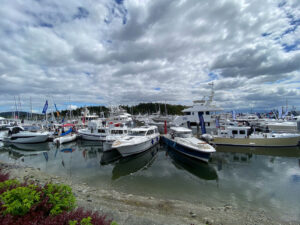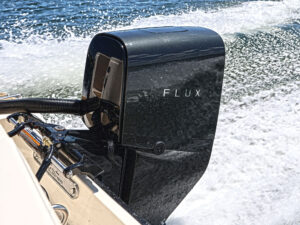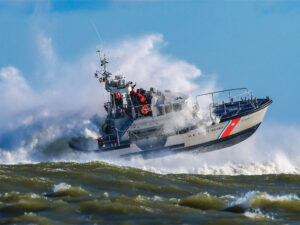Be sure to check out our video tour of the Stingray 235CR.
In a stressed economic world, finding and buying a new boat that will let you enjoy performance, comfort and style at a relaxed price is key. Sometimes low pricing is the sign of poor construction or of a distressed company with marginal capability to stand behind its product going forward. The Stingray 235CR cuddy we tested offered performance, style and comfort, and it comes from a company that, though not untouched by our economy, is certainly undefeated by it.
One way Stingray has prospered is by developing new European customers. In the process of responding to that market, Stingray engineers returned to their Hartsville, South Carolina, plant with new and functional style features for the 235CR — features that are seldom seen and only recently appreciated in the states. Europeans moor bow to shore to protect the prop from steep, rocky, glacial bottoms. So, as the europeans do, Stingray divided the sturdy bow rail at the center and cast the forward ends into sleek, ergonomic handles that ease boarding for crew members climbing the bow ladder, which is tucked into the ample anchor locker. Clever.
Clever too is the way Stingray minimizes manufacturing costs by minimizing parts inventories. And, instead of leaning toward the bargain components, it has found it can save money on warranty, manufacturing and inventory costs by using premium components and fewer, more-powerful engine options. Consider the smooth throttle and shift mechanism: the action is easy and super slick, thanks to Teleflex Xtreme throttle and shift cables that can be tied in a six-inch knot without binding. By building exclusively with Volvo Penta engines, inventory costs are further reduced and installation efficiencies are increased. Customers can enjoy these savings where it matters: on the water.
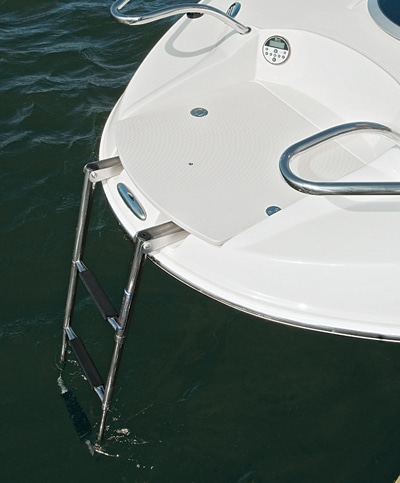
Minor details mean more than you might realize. A 2-inch fuel line takes fuel as fast as a truck-stop-size fuel nozzle can gush it out — without spitting or splashing from the fuel port. At idle, the boat is noticeably quiet, the result of mounting engines and even blower fans with vibrationdampening rubber bushings. To give the hull stiffness, a CNC (computer) cut, treated-plywood stringer system is bonded to the hull and encapsulated in fiberglass. A treated-plywood deck base is bonded and glassed for protection. Strength and beauty are added when the deck and integrated fiberglass sole are bonded in place over the top. The result is a sturdy, light boat that performs well and is ideally suited to lakes, rivers, bays and the intracoastal waterway. Should stormy weather catch one off guard, the 235CR has the brass to come home at reasonable speeds.
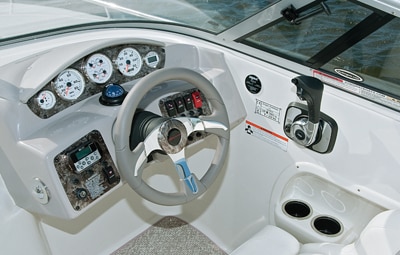
Although the cuddy in a 23-footer can be spartan, when I accessed it from the wide portside entry, passage was comfortable thanks to the overhead hatch that lifted, giving more headroom. Bowing to another European CE standard, the cabin threshold is raised, preventing deck water from splashing below. Inside, I found our test boat had a storage locker on the portside bulkhead and a pump-out head beneath the berth. A lounge seat can be converted to complete the extra-wide berth — doing so gave us more than six feet of stretching space both across the beam and lying feet forward. The only blot on the interior design is deck-railing bolts that, though they firmly hold rails in place, could have been capped for a better cabin finish. Rinker’s 210 MTX cuddy ($34,984) with a six-inch-narrower beam and two-foot-shorter length is comparably appointed, and the wide tri-point hull design does a lot to add space in the smaller cuddy.
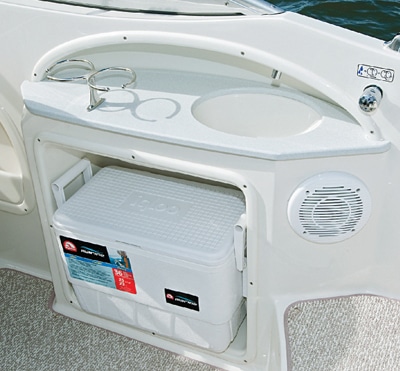
While I approved of the features to be enjoyed at anchor or when moored for overnighting, it’s what the 235CR does for the boating experience when I press the throttle forward that always gives me enthusiasm for this economical brand. The patented Z-plane hull has molded strakes in the bottom that add planing surfaces, without adding hull volume, to maximize lift and minimize drag. As the boat accelerated toward top speed, I could feel it step up on top almost like a bass boat does when it’s “on pad.” In turns, the Z-plane hull hooks up tightly and carries its weight with power, thanks to the relationship between the well-designed hull and dual prop drive in my test boat.
Cockpit design is equally efficient and comfortable. A fiberglass sole is easy to maintain, and a walk-through transom gives easy access from the large swim platform. I liked the comfort and position of beefy bucket seats with bolsters. The seats swivel fully aft for face-to-face conversations with the crew enjoying the aft lounges or the sun pad.
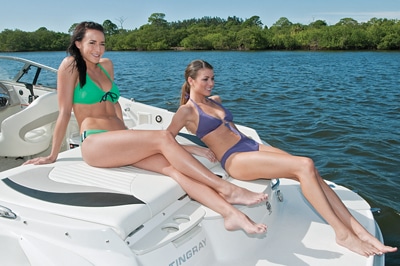
The layout is similar in the Regal 2250 Cuddy ($59,073), which also has a walkthrough transom, but the Regal offers a central entry hatch that narrows the foredeck steps. Stingray adds convenience with the cockpit galley sink, and access to the bow is easily navigated due to ergonomic design of the molded-in steps to the deck. The deck itself features an easy-cleaning nonskid surface, and the split bow rail offers easier access to the anchor locker than wraparound rails do. Clever, quick and comfortable; that’s what our test drive revealed this boat to be — and it comes in a hull size rare in today’s cuddy market.
Head over to the forums to let us know what you think of the new Stingray 235CR.
